 Adobe today released version 2.0 of the Lightroom CC cloud-based desktop application, along with Lightroom CC iOS 4.0 and Android 4.0.
Adobe today released version 2.0 of the Lightroom CC cloud-based desktop application, along with Lightroom CC iOS 4.0 and Android 4.0.
An update to Lightroom Classic was also released – see my Lightroom Classic article for details on this.
Lightroom CC Desktop 2.0 requires Windows 10 v1703 or later, or macOS 10.12 Sierra or later. To update to 2.0, go to Help>Updates, and on the Apps tab click on Update next to Lightroom CC (not Lightroom Classic or Lightroom CC 2015!). To update iOS, find the Lightroom CC app in the App Store and tap on Update; find the Android app in the Google Play store.
In This Article:
People View
Lightroom CC Desktop, iOS and Android now have a People function that will detect people in your photos and assist you in identifying them.
When you go looking for People in Lightroom CC Desktop, you’ll be inclined to click on the icon showing two people (![]() ), but don’t – that’s the new Sharing icon. Instead, click on the My Photos (books) icon and then below your date folders, People:
), but don’t – that’s the new Sharing icon. Instead, click on the My Photos (books) icon and then below your date folders, People:

This analysis of your photos takes place on Adobe’s servers, so it requires an internet connection. People who Lightroom CC has found in 5+ photos will be displayed. For people who are in less than 5 photos, find a photo with them, then open the Keywording tab and if a face has been identified, name them there. Once they are named, these people will show up in People view.

Note that if Lightroom misses detecting a face in a photo, there is no way at this point to force it to (for example, by drawing a face region).
Click here to go to a video tutorial and article with complete details on using People view.
Warning for Lightroom Classic Users
Please note that work you do with People in Lightroom CC on your mobile devices (and in Lightroom CC Desktop) WILL NOT SYNC TO LIGHTROOM CLASSIC, just like keywords won’t. Face tagging you do in Lightroom Classic will migrate to Lightroom CC People during your one-time catalog migration, but will not sync on an ongoing basis (in either direction).
Improved Search
Now in Lightroom CC Desktop, iOS and Android, as you start typing in the Search box you will get a rich set of suggestions based on the image source you are searching (an album, All Photos, etc.). Here’s an example:
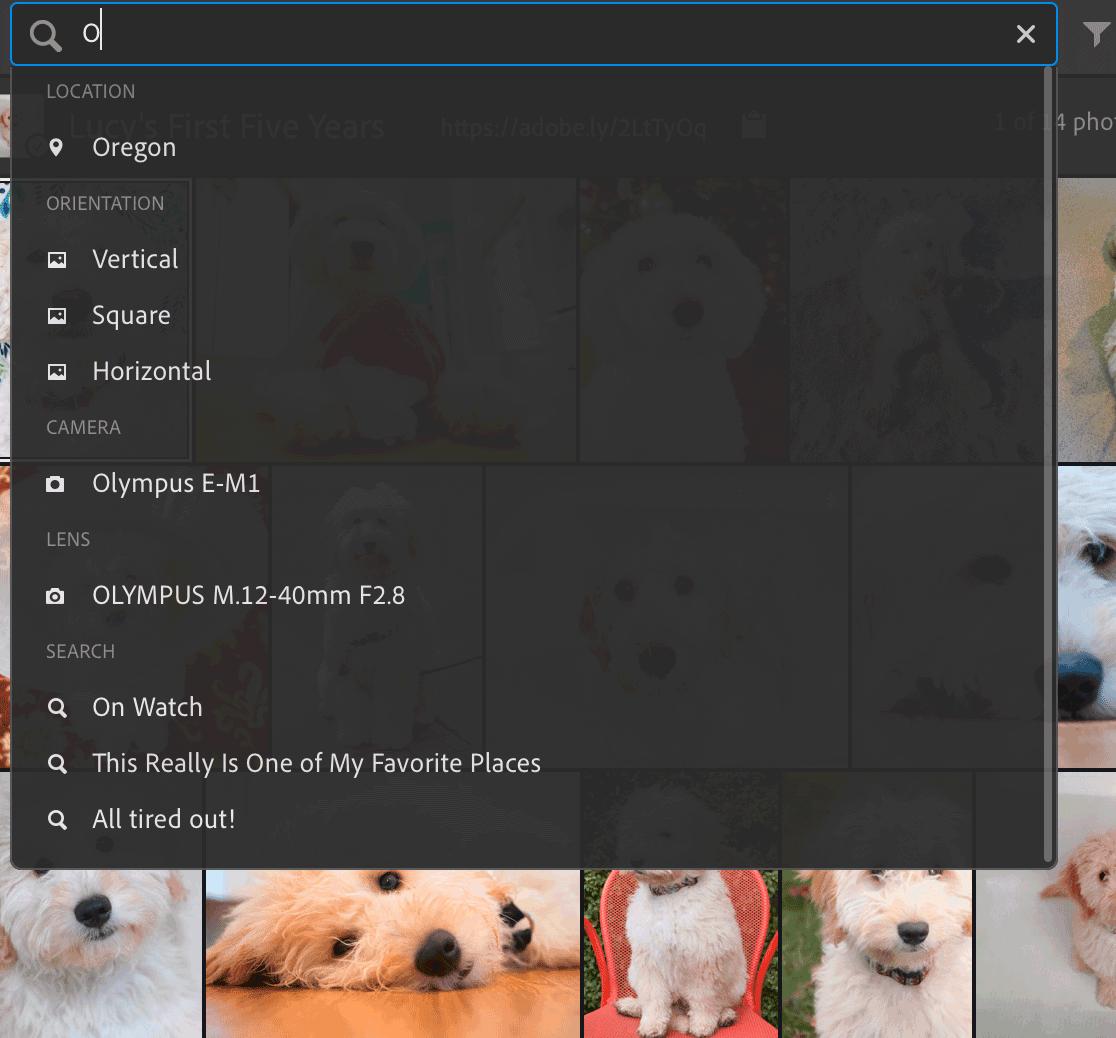
Click on the one you want, or if what you’re searching for isn’t listed, keep typing.
New Cameras Now Supported
Raw files from the following new cameras can now be imported into Lightroom CC Desktop, iOS and Android and into Lightroom Classic:
- Canon EOS R
- Fujifilm X-T3
- Nikon Coolpix P1000 (preliminary support)
- Nikon Z 7
- Panasonic LUMIX DC-LX100 II
Click here to see a list of all cameras supported in each version of Lightroom (and Camera Raw).
New Lens Profiles
Also New in Lightroom CC Desktop
Migrate Photos from Apple Photos to Lightroom CC
To import photos from Apple Photos into Lightroom CC, go to File>Migrate Apple Photos Library. Lightroom CC cannot migrate files that are missing in Photos or that are hidden – so resolve any missing file issues and unhide any hidden ones first. A Photos library can only be migrated once – this is not a way to continually import from Photos.
Upload Images to Adobe Portfolio
There is a new Connections section on the Sharing tab that will eventually allow uploading of images to many third party services. Right now you can upload to Adobe Portfolio, which is a free website-building service that is part of your Creative Cloud subscription. Click on the Sharing icon (![]() ), and in the Connections tab click on Add Connection, and connect to Adobe Portfolio.
), and in the Connections tab click on Add Connection, and connect to Adobe Portfolio.

Once this connection is set up, then to upload images, either right-click on an album and choose Share to… Adobe Portfolio, or select one or more photos, right-click in one and choose Share to…Adobe Portfolio. (The title you’re prompted to add is the title of the gallery or section on the site you’re building – but it can be changed later.)
To get to Adobe Portfolio and the images you uploaded, select an entry in the Portfolio connection and then click on the link above the grid:

If you edit photos after sending them to Adobe Portfolio, right-click on the entry in the Connections section of Sharing and choose Resend. To delete photos, do so from the Adobe Portfolio website, and then they will be automatically removed from the Lightroom CC Connections panel.
Share to Web: Photos Not in Albums
For some time we have been able to share an album on the web, by right-clicking on it and choosing Share to Web, copying the URL (link) that is displayed, and sharing that with our friends or clients. Now we can share one or more photos without having to first put them in an album: select one or more photos, right-click in one and choose Share to Web…, and then copy and share the URL. On the Sharing tab, you’ll see that there’s a new Photos section where these shares are displayed by date and time. These act just like albums – you can right-click and rename, copy the link, stop sharing, etc..
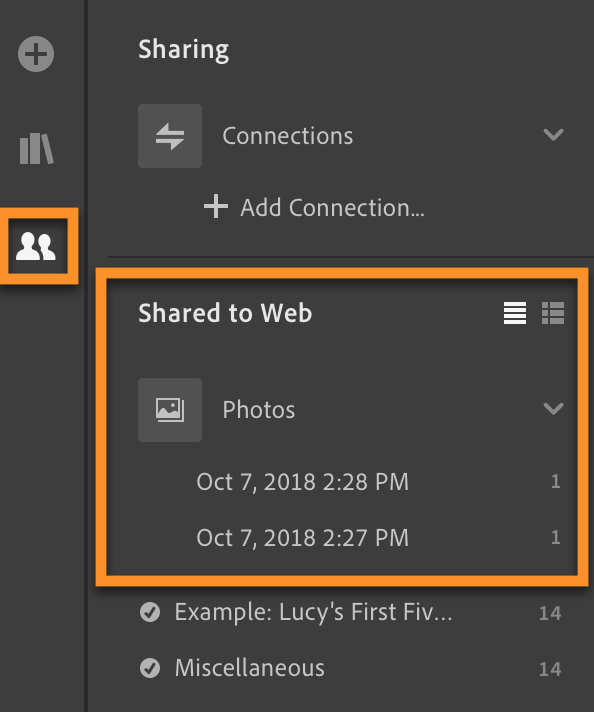
Help Options
For guided tutorials, a list of what’s new, and to set up Lightroom CC on your mobile devices, click on the question mark in the top right:
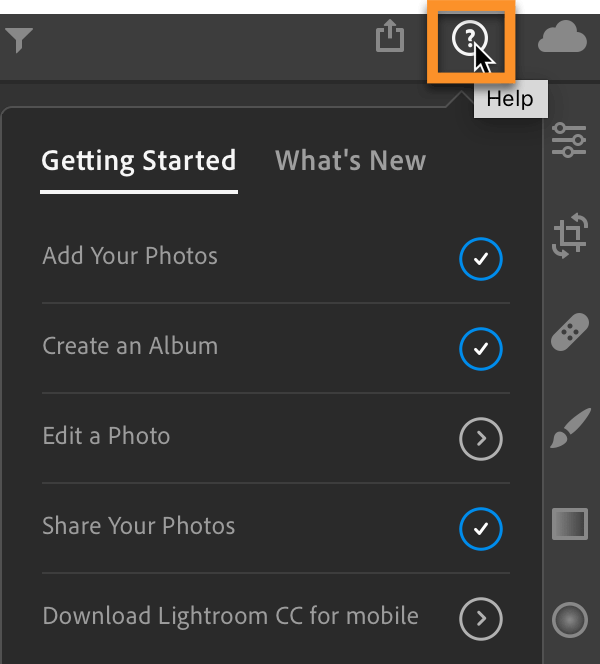
Also New in Lightroom CC iOS (iPad and iPhone) and Android
In addition to People view, improved search, new camera support and new lens profiles, the following is now available in Lightroom CC iOS 4.0, available in the Apple App store, and in Android 4.0, available in the Google Play Store:
New Share Tab
Easily access your shared albums and images on the new Share tab:
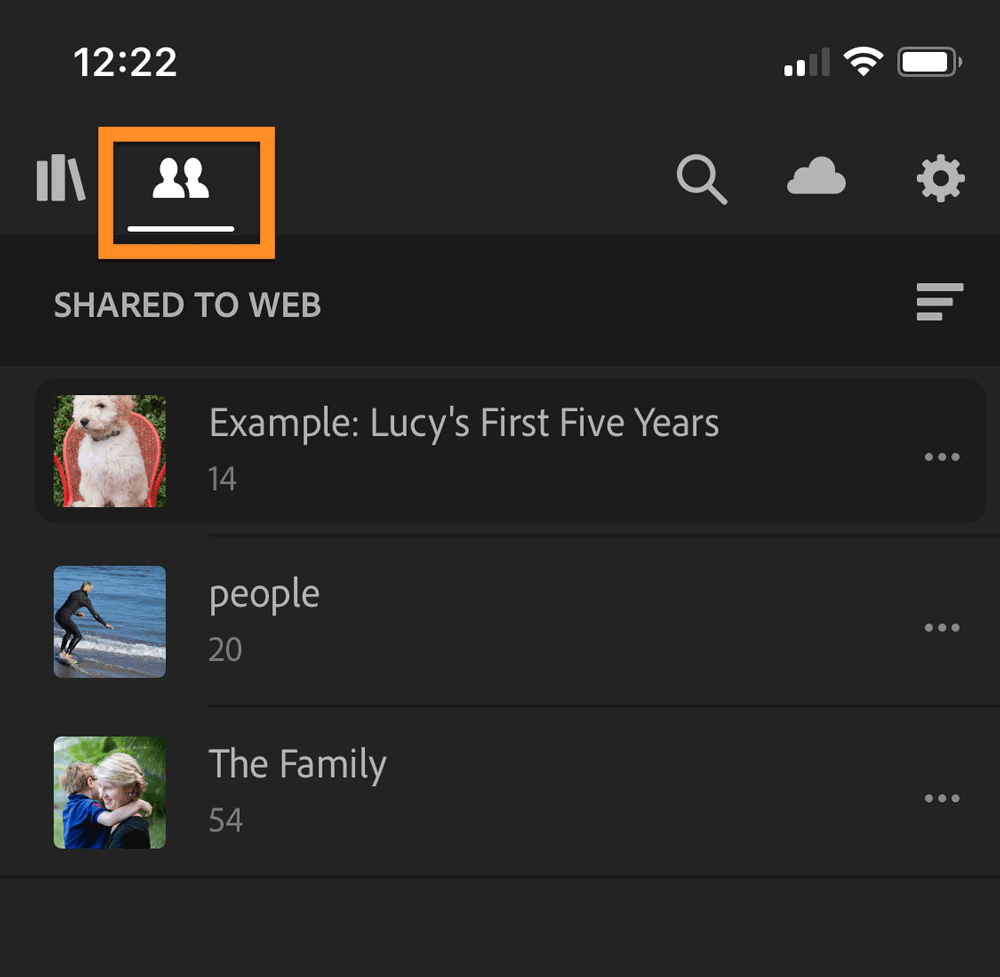
Shared Albums Display Options and Filter
Now choose from different display themes, and filter to display only images with a pick flag and/or a specified number of stars assigned. (For even more display formatting options, check out my article and video on using Lightroom Web’s new Display features.)
On iOS and Android, after entering an album:
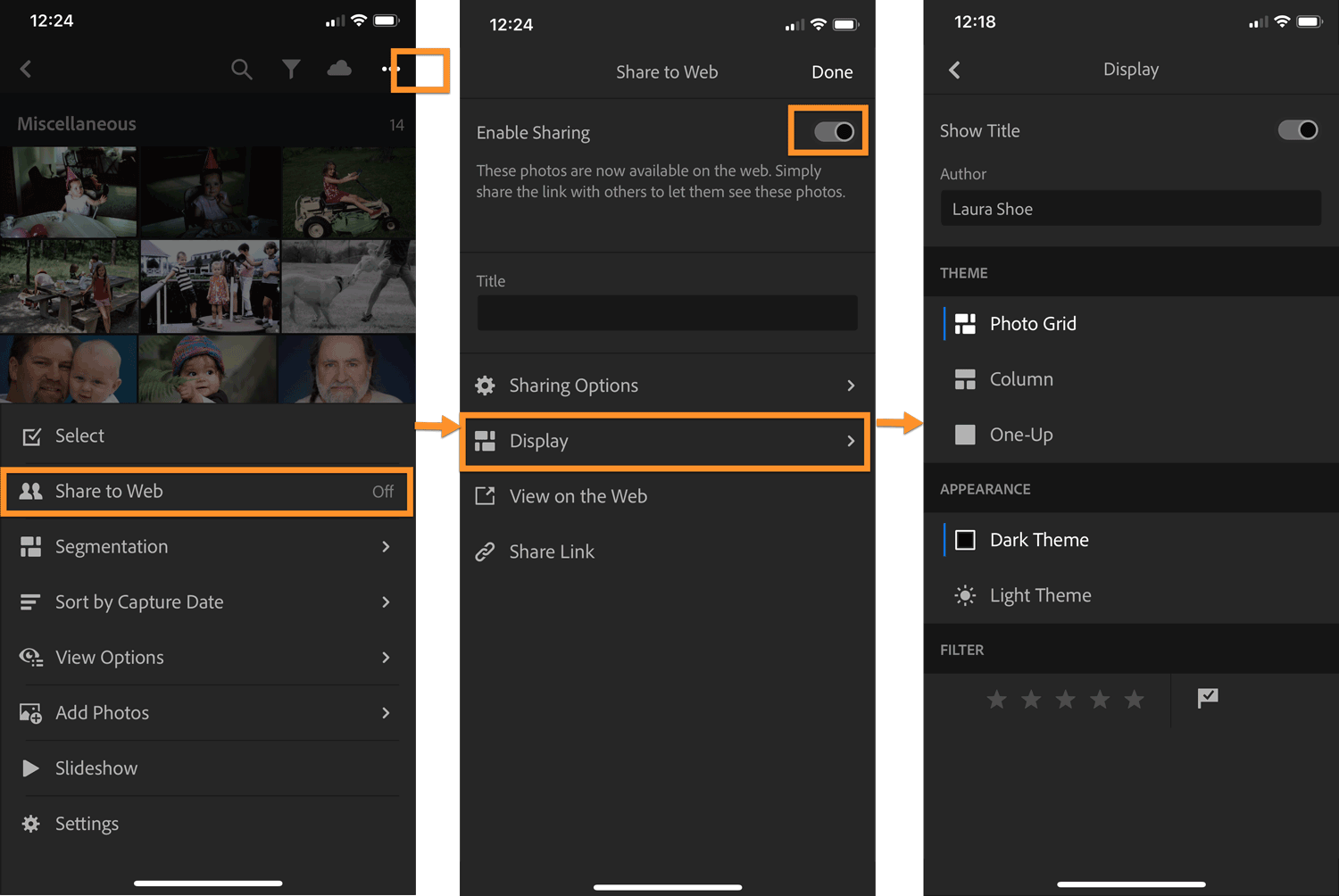
Also New in Lightroom CC Android
Faceted Search
Now in Lightroom CC Android 4.0 (in addition to iOS and Desktop), easily search for images from a particular camera, lens, or other facets (characteristics). In the Search bar, type in the facet name followed by a colon (:), and a list will popup with values present in your search location. For example, type camera: to select from a list of cameras you have shot with.

Below are the facets currently available. These aren’t listed in the application at this point, so make a note of them or bookmark this page.
Facets:
- keyword
- people
- camera
- lens
- location
- rating
- flag
- flash
- orientation
- iso
- type (image, video)
- extension (.jpg, nef, etc.)
- f-stop (aperture)
- ss (shutter speed)
- edited
There’s currently no way to select two or more values from the list at the same time (such as two cameras or a range of ISOs). To select more than one value of camera, for example, type camera: and select the first camera; then type camera: again and select the second. This creates an OR condition – images shot with either the first camera or the second one.
If you use a second facet in your search (or a non-facet search term), this will create an AND condition between facets (or between the first facet and the additional search term).
Example: camera: iPhone 6, camera: iPhone X, rating: 5-stars will be interpreted as:
(camera=iPhone 6 OR camera=iPhone X) AND rating=5 stars
To delete a facet from your search, hover over the facet and then click on the X on the facet. To clear the search entirely, click on the X to the right of the Search box.
![]()
Other Android Enhancements
- HDR quality improvements: purple patches, deghosting
- New guided tutorials: Targeted Adjustment Tool, First Time Adjustments (will launch when you first open an image into Loupe view
Related Content
Video tutorial and article: How to Use People View in the Cloud-Based Lightroom CC
New in Lightroom Web: Format Your Shared Albums and Collections!
What’s New in Lightroom Classic 8.0 – October 2018 Release
How to Use Depth Range Mask in Lightroom Classic CC
Adobe’s announcement about the Lightroom Classic and Lightroom CC Releases
